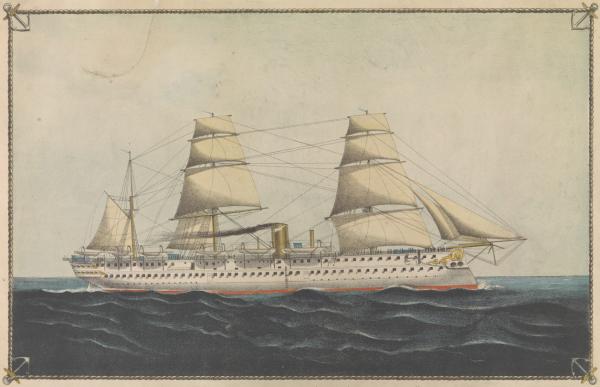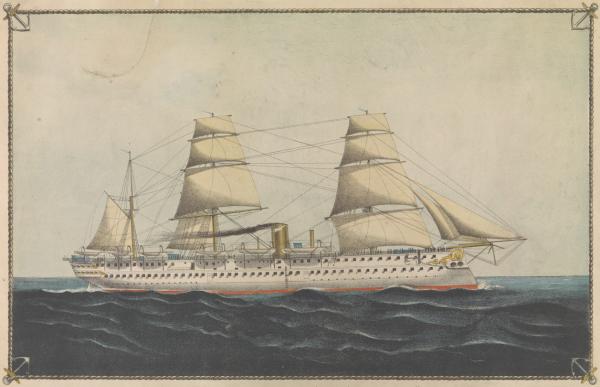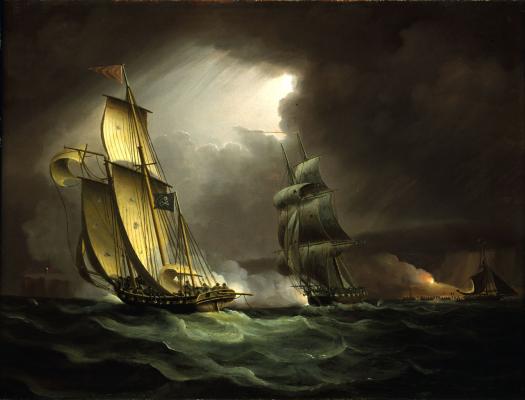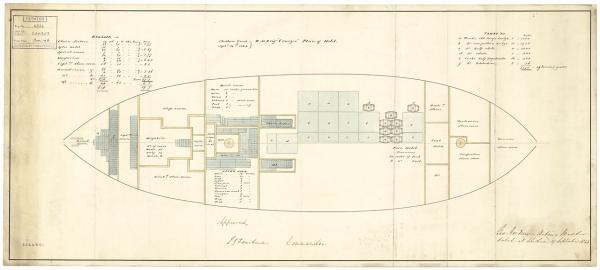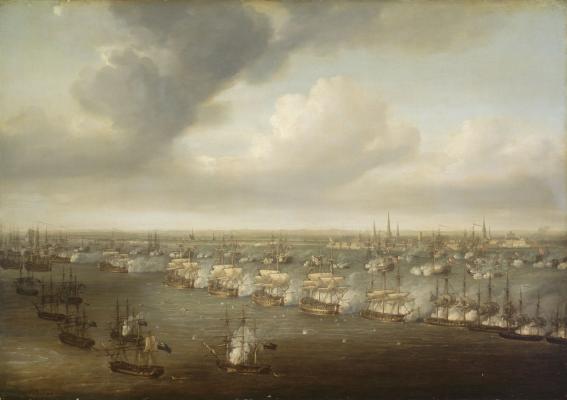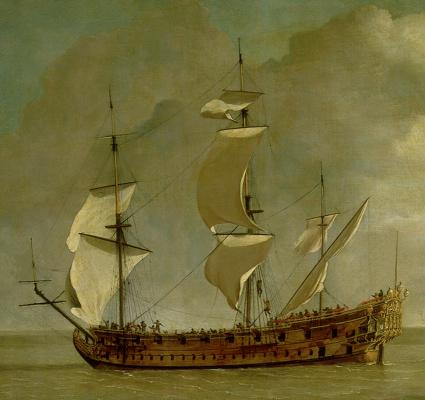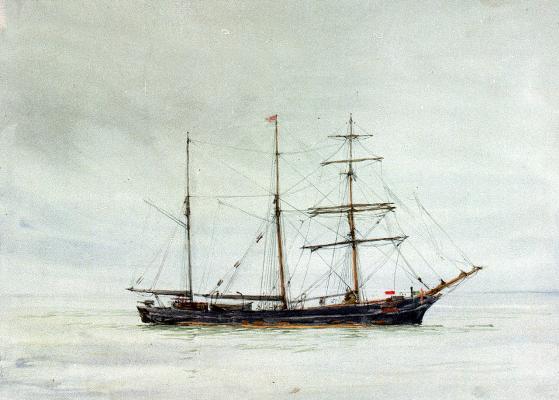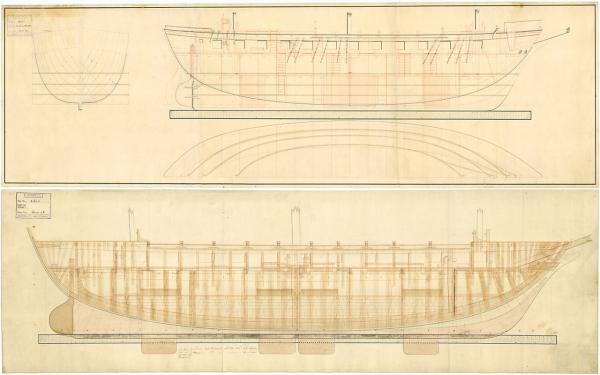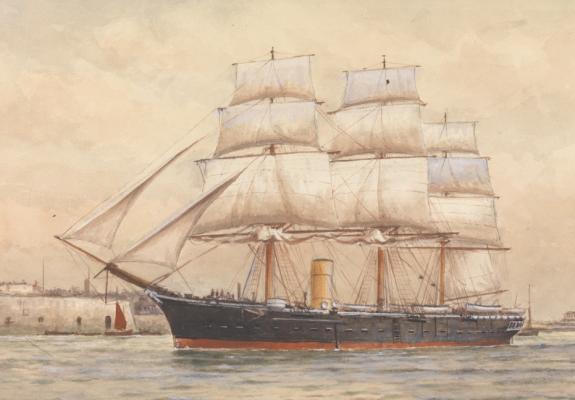-
Posts
455 -
Joined
-
Last visited
Content Type
Profiles
Forums
Gallery
Events
Everything posted by molasses
-
Not Prince Consort class.
-
Re-posting the image. Click it for full resolution. She was the lead ship of her class, all built in the same year. All were white, an unusual feature for Royal Navy ships of the time. Don't give up!
-
Not Mexican. Those ports were not for guns, she carried only three 4 pounders and she was a Naval vessel.
-
Not Japanese.
-
Not Russian or German.
-
Clues: iron hulled, not French, armed with 3 x 4 pounders.
-
Name this ship: This image was cropped to remove the name of the ship near the bottom edge and slightly retouched to remove flags. Good luck!
-
It's the German freighter Orion. She broke in half after being driven aground in a gale near Sunderland, England in 1913. After breaking in two the pieces were re-floated and moved near a pier in Sunderland where the pieces sank. Her remains were removed in 1988.
-

Cruizer-class Brig-Sloops of the Royal Navy
molasses replied to molasses's topic in Nautical/Naval History
I covered the first eight Cruizer-class brig-sloops that initially caught my attention. Now we go back to the beginning – and to the end. Cruizers, part 9: HMS Cruizer The Navy Board, on 19 December 1796, placed orders for four flush decked sloops based on designs by the two Surveyors of the Navy – Sir William Rule and Sir John Henslow. In order to evaluate the advantages and drawbacks of two masts compared to three, each hull design was built as a brig-sloop and as a ship-sloop. Before the Rule-designed sloops, Cruizer (brig) and Snake (ship), were 25% complete, one more of each were ordered, an unnamed brig and Victor (ship). The Board cancelled the brig before it received a name. Sisters to the Henslow-designed sloops, Busy (brig) and Echo (ship) were not ordered. The Cruizer-class sloops proved themselves fast sailors and seaworthy. When armed with a battery of 16 x 32 pounder carronades (+ 2 x 6 pounder chase guns) they delivered a close range weight of broadside that exceeded the weight of a 36 gun, 12 pounder frigate’s broadside. To an Admiralty constantly constrained by a shortage of crews, the design had great appeal – it delivered that firepower with about one-third the crew. Plan of lines, hull profiles, stern details of a typical Cruizer-class brig, Alert (1813) National Maritime Museum, #ZAZ4599 HMS Cruizer’s Specifications Length: 100 ft (gundeck), 77 ft 3 1/2 in (keel) Beam: 30 ft 6 in Tonnage: 382 (bm) Rig: brig-rigged sloop Armament at commissioning: 18 x 6 pounder guns Armament later: 16 x 32 pounder carronades + 2 x 6 pounder chase guns Complement: 121 HMS Cruizer launched on 20 December 1797, commissioned 2 February 1798 under Commander Charles Wollaston and joined Admiral Lord Viscount Duncan’s North Sea fleet. Commander Charles Wollaston, 1798 – 1801 Cruizer captured the French privateer Jupiter (8 guns, 36 men) on 27 April 1798 after a three hour chase. On 19 May, near Lowestoft, Cruiser pursued two French Republican luggers. After one dismasted herself trying to carry too much sail, Cruiser continued pursuit of the other until it became clear the lugger was widening her lead, and returned to take possession of the first. She was Chasseur (4 x 6 pounder guns, 48 men) and her escaped consort was Dragon (4), both vessels new and on their first cruise. On 16 April 1799, Cruiser captured Commerce, and, while in company with the frigates Latona (38) and Astrea (32) and the hired cutter Courier (12), she captured the Dutch hoy Dolphin. [The consulted records do not indicate the order of these captures, only that they occurred on the same day.] On 24 April, Cruizer in company with ship-sloop Scorpion (16) and hired cutters Fox (10) and Hazard (6) captured the Swedish brig Neptunus. Two days later Cruizer and Scorpion were present at the capture of the Adelaide. Cruiser captured the Vrouw Etje on 12 May 1799 and Reformator the following day. At 11 am on 21 May near St. Abb’s Head, Cruiser discovered two luggers to the south, well to windward, and gave chase. With unsettled and hazy weather, Commander Wollaston was not able to keep them in sight but found that he was steadily gaining on them in the intervals of clearer conditions. Just as Cruiser came into gun range at about 4:30 pm, a sudden gust of wind from shore carried away her fore topmast and main topgallant mast forcing her to heave-to to clear the wreckage. She soon made what sail she could and continued the pursuit until losing sight of them in the darkness at about 9 pm. Wollaston assumed that the luggers would continue on their southerly course along the coast of England. While sailing south during the night, Cruiser managed to erect another fore topmast and re-fit. At dawn, near Scarborough Castle, Cruizer found one of the luggers about 8 miles north of her, to leeward, and resumed the pursuit. Six hours later she captured the Deux Freres of 14 guns (12 of which had gone over the side during the chase) and 50 men. The other lugger, Tippoo Saib, had thrown overboard all 12 of her guns and her boat during the previous day’s chase and had separated from her companion during the night. In the evening of 12 July 1799, Cruizer re-captured an English vessel with a French privateer’s prize crew on board. After learning the time and place of the capture, Wollaston ordered Cruizer to set sail to find the privateer. The next day, Cruizer found and captured at “56 degrees N latitude” the Courageux (14 guns, 47 men) after a six hour chase. While in the process of inspecting two British brigs on 23 March 1800, Wollaston discovered a suspicious sail and immediately gave chase. After a five hour chase Cruizer captured the French privateer cutter Perseverant (14 guns, 47 men). According to Wollaston, “She is a remarkably fine vessel, copper bottomed, and has captured an amazing number of vessels in the North Sea.” While inspecting a brig from Bremen two days later, Wollaston learned from her master that he had been hailed about three hours earlier by a French brig steering northeast. Cruizer caught up with her and accepted her surrender at about 8:30 am. She was the Flibustier (14 guns, 54 men). Cruizer arrived at Yarmouth later that day with her prize. Cruizer and ship-sloop Pylades (16) captured Maria Charlotta on 22 May 1800. On 25 August 1800, Cruiser captured the Catharina Magdalena. Commander Charles Wollaston received promotion to post captain on 1 January 1801. Charles Wollaston advanced to the rank of Vice-Admiral on 23 November 1841 and died 19 February 1845 at the age of 78 years. Commander James Brisbane, 1801 Commander James Brisbane received command of Cruiser and remained briefly in Admiral Lord Duncan’s North Sea Fleet. On 23 February 1801, Cruizer re-captured the Aberdeen Packet and the Harriet of Sunderland. In April Cruizer transferred to a fleet assembling in Yarmouth under the command of Admiral Sir Hyde Parker and was subsequently assigned to Vice-Admiral Lord Nelson’s squadron. On 12 March, the fleet of 20 ships of the line, 5 frigates and several smaller vessels, totaling about 53, set sail to Copenhagen to persuade the Danes to return to peace negotiations. On 30 March, Brisbane on Cruizer supervised the setting of buoys by boats from Cruizer and Amazon (38) to mark shallow water in the Outer Channel between the Middle Ground shoals and Saltholm Island and took soundings to draw a map of the shoals in preparation for the battle. Cruizer continued charting shoals on the 31st. Commander Brisbane so impressed Admiral Nelson with his handling of these tasks that Nelson praised “the unremitting exertions of Captain Brisbane” in the first sentence of his report of the 2 April Battle of Copenhagen. James Brisbane returned to Yarmouth, received promotion to post captain and the command of Saturn (74), flagship of Admiral Thomas Totty. Many other officers of all ranks also received promotion after the battle. Commodore Sir James Brisbane died on 19 December 1826 of dysentery in Penang, Malaya while in command of the East Indies Station. Throughout his career, Brisbane demonstrated adeptness and skill at coastal and riverine operations first shown while in command of Cruizer at Copenhagen. The Battle of Copenhagen, 2 April 1801, by Nicholas Pocock British bomb vessels at lower left, British line, Danish line, Copenhagen in background. Cruizer was at the south end of the line to the left off the painting. National Maritime Museum Commander John Hancock, 1801-1806 Commander John Hancock took command of Cruizer as part of the North Sea Fleet in April 1801. Admiral Nelson in a letter to a friend dated 31 August 1801 wrote that Captain Hancock had landed two captured brass guns worth 400 to 500 pounds apiece at Yarmouth and that it was believed he had more aboard Cruizer. This bit of information suggests that Cruizer carried a pair of brass chase guns (6 pounders being the most likely) in the stern ports at about this time. Cruizer captured Antonious and Jonge Jacob on 10 October 1801. NMM records have Cruizer [re]commissioned in February 1803 with Commander Hancock still in command. It is possible that Cruizer had been refit and her armament changed to 16 x 32 pounder carronades + 2 x 6 pounder chase guns prior to that date. The Navy Board ordered six Cruizer-class brig-sloops on 27 November 1802, one of them in Cruizer’s home port of Yarmouth. It seems likely that Cruizer would have her armament upgraded to that of the new brigs soon after. In addition, after five years of operation since commissioning, Cruizer would be about due for a refit. On 14 June 1803, boats of the Immortalite (36), Jalouse (18) and Cruizer took L'Inabordable and Merchante [James has the name as Commode] French gun-brigs near Gris Nez after they had run aground under the guns of a shore battery for protection. Cruizer captured Neptunus on 18 July 1803, recaptured Margaretta on 4 August and captured Flore on 5 August. On the night of 8 March 1804, boats of Cruiser and Rattler (16) cut out the cutter Colombe at Sluys but it ran aground and was burned to prevent recapture. Later that month thirteen armed vessels brought troops out from Vlissingen to attack the moored blockading brig Cruiser and ship-sloop Rattler near Blanckenberge. The sloops repulsed the boarding attempts and chased the boats back to shore until shoaling water and the Ostend batteries ended further pursuit. On 22 April, James Douglas, a petty officer in Cruizer, was flogged around the fleet for beating and ill treating a prisoner on board a prize of which he was prize master. The Vlissingen Flotilla, 15-16 May 1804 Commodore Sir William Sidney Smith in Antelope (50) commanded the squadron of smaller vessels, including Cruizer, blockading the coast from Ostend to Vlissingen. These widely separated vessels communicated using ensign-size signal flags with messages relayed from ship to ship. On the evening of 15 May, Cruiser and Rattler observed 22 one masted gun vessels and a schooner haul east out of Ostend and take up an anchorage westward of the lighthouse behind a sand bar. Commander Hancock signaled to Minx (14) and the other three gun-brigs on their way westward toward Calais to return. This signal was either misunderstood or not seen. He also dispatched the hired armed cutter Stag (14) at 9 pm to report the situation to the Commodore on Antelope which Stag found at 5:30 the next morning. Cruiser and Rattler, after darkness fell, anchored in position to cut off this flotilla from returning to Ostend at the extreme range of one of the Ostend batteries. At daybreak on 16 May, Hancock again recalled the four British gun-brigs, still in sight, but again the signals were misunderstood or not seen. At 9:30 am, Rattler, being further east, made signal for five sail, then for a fleet to the east sailing towards Ostend from Vlissingen. This was the Vlissingen flotilla under the command of Rear Admiral Ver-Huell, which set sail at dawn bound for Ostend. The flotilla consisted of two ship-rigged prams of 12 x long 24 pounders, Ville D’Anvers, flagship, and Ville D’Aix, 19 schooners and 47 schuyts, in all 68 sail mounting over 139 guns 18 pounders or larger, 230 smaller guns, carronades or mortars and carrying 4000 to 5000 men. At 10 am, the earliest the tide allowed, the two sloops set sail toward the enemy. At 11 am, the wind shifted to the south west, helping the sloops but almost dead foul for the Gallo-Batavian flotilla now near Blanckenberge, forcing the Dutch admiral to order the return to Vlissingen. At about noon, Commodore Smith on Antelope with Penelope (36) and Aimable (32) made their appearance from the north threatening to cut off the flotilla’s escape back to Vlissingen. At about 1:30 pm, Cruizer came up with, fired at and compelled to strike, one of the rearmost schuyts mounting one 36 pounder and carrying five Dutch crewmen and 25 soldiers. While signaling to Rattler to take possession of the schuyt, Cruizer pursued the flotilla’s flagship. Further wind change allowed Admiral Ver-Huell to reverse the flotilla’s course again back towards Ostend; all but eight of the flotilla followed this order, those eight continued on to Vlissingen. At about 1:45 pm, Ville D’Anvers fired a shot at Cruizer, passing over her and almost hitting Rattler. At about this moment the wind changed again, nearly setting Cruizer and Rattler aback and allowing Ville D’Anvers to close and commence firing on Cruizer. Within minutes both Cruiser and Rattler found themselves engaged on both sides by Ville D’Anvers and other vessels and under fire of the Blanckenberge batteries. At one point Cruizer fought off boarding attempts by several schooners that had closed to board, one of which had her bowsprit over Cruizer’s deck until it fell from a shot from a carronade [one of Cruizer’s? suggesting she was armed with them at this time]. Cruiser and Rattler managed to drive on shore the pram Ville D’Anvers and four of the schooners. At 3:45 pm Aimable arrived and opened fire on a portion of the flotilla huddled under the Blanckenberge batteries. At 4:30 Penelope and Antelope also got into action and by their heavy fire drove several more schooners and schuyts on shore. At 7 pm Aimable came under fire of the grounded pram Ville D’Anvers and at 7:45 pm, Antelope signaled the squadron to withdraw due to the falling tide and they drew away to deeper water in good order. Casualties on the British vessels were very light considering the duration and intensity of the action. Cruiser had one seaman killed and the captain’s clerk and three seamen wounded; Rattler, two killed and three wounded; Aimable, seven killed and fourteen wounded; total, 13 killed and 32 wounded. Besides cut rigging, only Cruizer suffered significant damage – two large shot holes near her waterline. The Gallo-Batavian flotilla lost 18 men killed and 60 wounded, 4 killed and 29 wounded on the two prams. On 17 May, the gun-brigs, having rejoined the squadron, attempted to complete the destruction of the Ville D’Anvers but were unable to do so because of the shore batteries and newly set artillery batteries that drove them off. On 19 May, the gun-brigs in company with the 16-gun ship-sloops Galgo and Inspector, attempted a second attack on Ville D’Anvers but failed for the same reasons. Ville D’Anvers and five of the eight grounded schooners and schuyts managed to refloat and get into Ostend on a high tide later that day. The only British casualties suffered on these two days occurred in accidents with five dead and six injured. On 16 October 1804 at 9 pm, Cruizer, in company with the gun-brig Bold (14), hired armed brig Ann (10) and the cutter Florence (6) all close in at Ostend, observed a strange brig standing in then suddenly turn away and set all sail. Cruizer and company immediately set all sail in pursuit and followed her all through the night. At 4:45 am, with a wind that had steadily freshened through the night, the strange brig lost both her top masts. Due to the morning haze and the darkness of the hour, Commander Hancock did not see the brig’s accident or her actions after - she had cleared all sails and dropped anchor in the hope that her pursuers would sail right on past giving the brig the weather gauge or would miss sight of her completely. Cruizer had outdistanced her three consorts (out of sight by midnight) and, upon losing sight of the brig, had reduced sail slightly to avoid exactly what the brig’s captain had hoped would happen. Cruizer passed within hail of the brig, and not receiving an answer except that the brig was from Philadelphia, in bad English, ordered three rounds fired from her carronades into her [a specific mention of her carronades, setting the end of a definite period of time in which Cruizer’s battery was upgraded]. The privateer Contre Amival Magon (18) surrendered as Cruizer prepared to fire a passing broadside into her quarter from ten yards. By Cruizer’s hourly log the eight-hour chase had covered 100 miles. This gives a documented average speed of no less than 12 knots. The captain of Contre Amival Magon was the notorious privateer Captain Blackeman or Blauckman (spelling varies even in Hancock’s official reports) who had escaped capture on three previous occasions. The Contre Amival Magon was a new brig, pierced for 18 guns but carrying 17, out on its first cruise. Blankeman had captured three vessels, the ship Belisarius, and the collier brigs Scipio and Contents Increase in the preceding 18 days. A British brig recaptured Contents Increase just two hours after her capture on 10 October. The masters and crews from the three vessels were on board Contre Amival Magon when captured. She carried a crew of 84 French, Danish, Swedish and American sailors. Seven Americans, out of work and facing time in a prison hulk, promptly joined the crew of Cruizer. Commander Hancock escorted his prize to Yarmouth and submitted his report that same morning, 17 October 1804. He left Blachman with the Rear Admiral of the North Sea Squadron, Thomas McNamara Russell on HMS Monmouth (64). Blanckman escaped soon after. The Ostend Flotilla, 23-24 October 1804 On 23 October at 4 pm, a division of the Ostend flotilla consisting of two prams, one with a commodore’s pendant, and 18 armed schuyts put to sea from Ostend steering west. At about the same time Cruizer with gun-brigs Blazer (14), Conflict (12), Escort (14) and Tigress (12) and hired armed cutters Admiral Mitchell (12) and Griffin (8), stood in to reconnoiter and immediately gave chase. At 5:15 pm, Cruizer engaged the lead pram with support from the gun-brigs and cutters. At 6:35 pm, after the lead pram’s guns had fallen silent and Hancock realized he was on a falling tide in less than three fathoms of water – Cruizer drew over two – he hauled off todeeper water and anchored. During that time, Conflict also engaged the prams but soon ran aground. Lieutenant Charles C. Ormsby, in command, tried to lighten Conflict but all efforts were futile in the falling tide. After the two prams passed by on either side of Conflict Ormsby decided that he needed to quit his brig and save the crew. Once in the boats they pulled towards the anchored Cruizer. After Commander Hancock received Lt. Ormsby’s report, he ordered him and his crew back on their boats to affect either Conflict’s recapture or her destruction with support from the Admiral Mitchell. The ebb tide delayed their return for a time but when they eventually approached Conflict they found her high and dry on the beach defended by infantry and a battery of artillery and gave up the attempt. When they returned, Commander Hancock sent them back again with Admiral Mitchell, Griffon and a detachment of sailors and marines commanded by Acting Lieutenant Abraham Garland from Cruizer. This attempt was repulsed with one dead and seven wounded including Lt. Garland with his right leg severed at the thigh. The next day the damaged, beached pram was refloated and sailed to the west. Conflict most likely broke up on the beach (as suggested by Hancock in his report) but the records do not confirm this. Cruizer had four wounded in the action; Conflict, one dead and five wounded; and Griffin, two wounded; total one dead and eleven wounded. The French lost no vessels and suffered unknown casualties. On 11 February 1805, Cruizer and Ann captured Hoop. On 8 March, Cruizer captured the privateer galliot Triton and her prize, Vriendjchap. On 15 March, Cruizer, gun-brig Minx, and Bold captured Industria. On 29 June 1805, Cruizer captured Johanna Tholen. On 2 August, Cruizer and Ann captured Frederick and on 23 August, they, with Minx, Active (6) and Griper (14) captured Susannah Margaretha. On 5 September, Cruizer, Minx, Active and Mariner (14) captured Sophia Amelia and on 29 September, Cruizer recaptured Rover. On 12 November at 7 pm, Cruizer interrupted two French privateer luggers taking a brig and gave chase to the larger for two hours until bringing down her main topsail and main lugsail with Cruizer’s chase guns, forcing her to surrender. Vengeur of 14 guns and 56 men was two days out from Boulogne and on that same afternoon had captured two Swedish brigs. On 27 January 1806, Commander Hancock disguised Cruizer as an American vessel looking for a pilot near Vlissingen, decoyed a cutter in close, captured her and manned her as a tender under Lieutenant John Pearse. Between them, they succeeded in capturing seven more blockade runners in the next few hours, six luggers and a schooner laden with cargoes including 26,000 gallons of spirits and several tons of tobacco. Upon his return to Yarmouth with his eight prizes, Commander John Hancock found he was promoted to post captain and Commander Pringle Stoddart was to be in command of Cruizer. Commander Pringle Stoddart, 1806-1807 Cruizer with Commander Pringle Stoddart in command remained part of the North Sea Fleet. On 20 September 1806, Cruizer captured the fishing boat Fortuyn. and another, St. Wareld Beloop on 12 October. At 8 am on 6 January 1807, Cruizer gave chase to a suspicious lugger and four hours later captured the privateer Jena, of 16 3 and 4 pounder guns. Jena had aboard the masters and crews of three vessels captured in the fourteen days after she was launched. A brig chasing a pirate/privateer/smuggler by Thomas Buttersworth (1768-1842) National Maritime Museum At 2 am on 26 January, a lugger passed Cruizer on her weather beam on the opposite tack. Cruizer turned and attempted to follow but could not lie as close to the wind as the lugger but the wind soon veered further west allowing Cruizer to follow in the lugger’s wake. Cruizer eventually forced the lugger onto the beach three miles west of Blankenberge where the master and crew escaped. Commander Stoddart anchored and sent in his boats to take her off or destroy her. The officers and men succeeded in getting the privateer Brave (16) off the beach under musket fire from the dunes above the beach without incident. On board Brave were the masters and crews of two vessels she captured. One of these, Leander, was recaptured later that day. Cruizer also recaptured the Guardian, a prize taken by the privateer Revanche. In August, Cruizer was transferred to Admiral James Gambier’s fleet for another battle at Copenhagen. On 22 August, three Danish Prams of 20 guns each and 28 to 30 smaller gun vessels positioned themselves for an attack the next morning on the seaward flank of British batteries (the Mill batteries) under construction opposite the Danish batteries near the entrance to the harbor of Copenhagen. In response, Admiral Gambier ordered the British inshore squadron to form up to defend that flank. The squadron consisted of Cruizer, her new sister Mutine, and Kite (16), bomb-vessels Thunder (8), Zebra (18), Fury (12), Aetna (8) and Vesuvious (8), gun-brigs Fearless (12), Indignant (12), Urgent (14), Pincher (14), Tigress (12), Desperate (14) and Safeguard (14), the hired armed ship Hebe (16), three armed transports and 10 ships’ boats outfitted as mortar-boats. At 10 am 23 August, the Danish squadron, supported by the Trekronen Batteries, floating batteries, block ship Mars and the pram St Thomas, attacked the British squadron. At about 2 pm, seeing that the British carronades were ineffectual at the range of the long guns of the Danes, Captain Puget of Goliath, in command of the squadron, ordered it to withdraw. The squadron suffered the loss of one lieutenant (John Woodard of Cruizer) and three seamen killed and one lieutenant, seven seamen and five marines wounded. The gun-brigs, drawing the least water and being closest to the enemy, suffered the most physical damage. The Danish squadron turned its attention to the Mill battery but was driven off after taking damage and casualties while causing little to the British battery. On 25 August, Danish gun boats attacked a different exposed seaward flank of the British line without opposition from the British fleet to little effect. The next day, the Danish gunboats returned to attack the Mill battery but were repulsed after one blew up from a British mortar shell exploding in its powder magazine with heavy loss. On 31 August the Danish gun boat squadron attacked the Mill battery and inshore squadron, reinforced by the repaired gun-brigs. During this action, the British armed transport Charles blew up from a Danish mortar shell. The action ended inconclusively with the British losing 10 killed and 21 wounded (almost all from the explosion) and the Danes one killed and four wounded. The naval activity at the Siege of Copenhagen amounted to little more than these small vessel actions and the landing of troops. On 2 September, Cruizer captured the Emanuel near Copenhagen. Cruizer arrived in Yarmouth with dispatches from Copenhagen on 11 September. On 8 December 1807, a notice published in the London Gazette announced the payment of salvage money for the recapture of Famalien to the officers and crew of Cruizer, Pringle Stoddart, Commander, but the date of the recapture is not mentioned. Commander Pringle Stoddart relinquished command of Cruizer to Commander George Charles Mackenzie sometime after 11 September 1807. Commander George Charles Mackenzie, 1807-1808 In the evening of 11 June 1808, Euryalus (36) and Cruizer, discovered several vessels at anchor in the Great Belt near Korsor. Captain the Honourable G. H. L. Dundas immediately dispatched the boats from the frigate and brig under the command of Lieutenant Michael Head to attempt their destruction. The boats attacked the vessels, despite the covering fire from a battery of three long 18 pounders and Danish musketry, and captured the gun boat E mounting two 18 pounders with a crew of 64 and burned two transports fitted to carry troops while suffering but one man slightly wounded. Lieutenant Thomas Wells, 1808 On 1 October 1808, Cruizer, acting commander Lieutenant Thomas Wells in command, while close in at the entrance of Gottenbourg, encountered about twenty armed cutters, luggers, gun boats and row boats intent on capturing Cruizer. Lt. Wells responded quickly and captured a schuyt of ten 4 pounders and 32 men and compelled the rest of the flotilla to seek shelter under the guns of a shore battery. Between 1 and 5 November, Cruizer captured the Danish vessels Rinaldo, Probert, Kirstina and Trende Brodre and recaptured Maria Elizabeth. Cruizer, with the gun-brig Starling (12), captured Elbe, St. Joanna, Vrou Sophia, Yonge Ness, Fier Brodre, Speculation, Erndte, Prince Charles, Aurora, Lawrence Caroline and Two Brothers from 22 to 25 November. Lieutenant Thomas Wells received confirmation of his promotion to Commander and a different command. Commander Thomas Richard Toker, 1808-1813 Commander Thomas R. Toker took command of Cruizer in late November or December 1808. Between 12 and 21 March 1809, Cruizer captured the Danish vessels Albion, Printz Frederick, Erstatning and Unge Maria. In April Cruizer captured St. Johannes on the 9th and Lille Peder on the 27th. On 7 May 1809, Cruizer, off Pillau, delivered a letter for Louis Drusina, a diplomat turned secret agent. On 8 May, Cruizer and the gun-brig Urgent captured the Danish privateer Tilsit and her prize Experiment. On 31 May, Cruizer with Rose (18) captured the Danish privateer brig Christianborg of 6 guns and 37 men off Bornholm. On 19 June 1810, Cruizer captured the Danish galliot Frau Magdelena and on 26 June, the Prussian sloop Jonge Laura. Cruizer, on 31 July 1810, captured the Prussian sloop Schwan On 21 August, Cruizer and the cutter Cheerful (12) captured Albertina On 17 September, Commander Toker captured the Danish galliot Familiens Well. In the week ending 2 Oct, Cruizer captured Schwan, Blanch, Albertina and Byie. Cruizer set sail from Yarmouth for the Nore on 20 January 1811, was refit at Chatham in November 1811, was in Portsmouth in February 1812 and was listed as being in Sheerness in 1814. Cruizer was sold for breaking on 3 February 1819. The Cruiser ship-sloop (1828) The last sloop built from Sir William Rule’s plan first used for Cruizer is the ship-sloop Cruiser. She launched 19 January 1828, commissioned soon after and left Chatham with John Colpoys in command in October 1828 for duty on the East Indies Station. After conversion to a brig in 1831, Cruiser returned to station in the East Indies, Commander John Parker in command. In August 1833, Commander John M’Causland and Cruiser were assigned to the North America / West Indies Station primarily for piracy and slave trade suppression. On 14 Jan 1835, acting commander Lieutenant James Vashon Baker, in command of Cruiser, captured the slave vessel Maria. Commander W. A. Willis received command of Cruiser in October 1835. Richard King took command in February 1838, on the East Indies Station. On 18 January 1839, Cruiser accompanied Volage (28) and several other vessels with troops on a strike against Aden, an Arab pirate stronghold, and captured it. The strike force destroyed 33 guns of several calibers in the pirate batteries, killed approximately 50 pirates and captured 140 more. Commander Henry W. Giffard received command of Cruiser in May 1839 in the East Indies and participated in the campaign leading up to the bombardment and capture of Chusan, an island near the mouth of the Yangtze River, on 5 July 1840. Cruiser was reported at her station off Canton on 2 March 1841. [One source has Cruiser being converted back to a ship sometime in 1840, most likely after 5 July. However, NMM has a plan of Cruiser’s hold as a brig that casts doubt on an 1840 conversion, dated 14 September 1844, at Chatham, and signed by Commander E. G. Fanshawe and the brig’s Master.] 3 Jul 1841, Commander H. W. Giffard, Cruiser, promoted to Captain. Lieutenant W. Haskoll, Cruiser, promoted to Commander. Cruiser was at Chatham in 1844. Plan of Cruiser’s hold as a brig made at Chatham in 1844. National Maritime Museum, #ZAZ4801 On the morning of 18 August 1845, a landing party of 300 sailors and 200 marines supplied from seven vessels of the East Indies Fleet, including Cruiser, assembled to attack the pirate stronghold of Seriff Housman in Maluda Bay, Borneo, defended by two or three batteries, a fort, a heavy boom spanning the river and 500 to 1000 men. The landing party loaded into all of the fleet’s boats, some fitted as gunboats, with Commander Fanshawe of Cruiser as second in command of the operation. This force attacked the boom under fire from the batteries. After fifty minutes, the boom gave way and the landing force swarmed along the river banks, stormed the batteries and fort and quickly swept away all opposition. The men wrecked or removed the guns and destroyed everything of value they could find. The landing party suffered eight dead or mortally wounded and thirteen wounded. The casualties among the pirates were not estimated, as they carried away their wounded and many of their dead, but were described as “immense”. Upon return to the ships, a second force was dispatched to return to the town and complete its destruction. This second group returned with the brass guns from the destroyed batteries. Commander William MacLean received command of Cruiser in December 1846. Cruiser was sold at Bombay in 1849. Next: Weazel Edited to add a photo Sources: The Naval History of Great Britain by William James, 1824 Naval Biographical Dictionary by William R. O’Byrne 1849 “NMM, vessel ID 383036” [Cruizer], Warship Histories, vol xii, National Maritime Museum “Cruizer 1797”, “Cruizer 1828”, et al. www.ageofnelson.org “Cruizer 1797”, “Cruizer 1828”, et al. www.pbenyon.plus.com “HMS Cruizer (1797)”, “Cruizer-class brig-sloop”, “Battle of Copenhagen”, articles on Wikipedia (online) London Gazette, 28 April 1798, #15011, p.354; 19 May 1798, #15017, p.424; 21 May 1799, #15136, p.491; 16 July 1799, #15160, p.718; 25 March 1800, #15242, p.298; 18 October 1800, #15303, p.1200; 3 March 1801, #15342, p.257; 7 March 1801, #15343, p.266; 14 November 1801, #15427, p.1374; 14 November 1801, #15427, p.1375; 17 November 1801, #15428, p.1393; 13 July 1802, #15497, p.751; 3 May 1803, #15581, p.528; 14 May 1803, #15584, p.507; 4 May 1805, #15804, p.607; 7 May 1805, #15805, p.624; 15 April 1801, #15354, p.402; 11 August 1801, #15396, p.994; 31 December 1803, #15662, p.7; 23 October 1804, #15748, p.1320-1322; 27 October 1804, #15749, p.1335; 6 November 1804, #15752, p.1368; 17 November 1804, #15755, p.1412; 1 June 1805, #15812, p.738; 12 November 1805, #15862, p.1412; 19 November 1805, #15864, p.1453; 10 December 1805, #15871, p.1556; 14 December 1805, #15872, p.1569; 24 December 1805, #15875, p.1603; 12 August 1806, #15945, p.1067; 12 August 1806, #15945, p.1069; 16 August 1806, #15946, p.1084; 30 August 1806, #15950, p.1141-1142; 3 February 1807, #15997, p.144; 10 February 1807, #15999, p.179; 14 February 1807, #16000, p.197; 26 May 1807, #16032, p.718; 4 August 1807, #16053, p.1034; 3 September 1808, #16179, p.1220; 6 September 1808, #16180, p.1233; 22 May 1813, p.999; 10 January 1807, #15990, p.34; 3 February 1807, #15997, p.141; 10 February 1807, #15999, p.179; 21 February 1807, #16002, p.229; 1 August 1807, #16052, p.1018; 5 December 1807, #16093, p.1636; 3 July 1810, #16384, p.990; 10 January 1810, #16341, p.222; 23 January 1820, #16336, p.125; 27 January 1810, #16337, p.139: 30 January 1810, # 16338, p.160; 9 June 1810, #16377, p.846; 21 May 1814, #16900, p.1066; 31 December 1816, #17205, p.2494; 4 January 1817, #17206, p.12; 10 June 1809, #16265, p.853; 24 February 1810, #16345, p.291;13 November 1810, #16424, p.1811;27 November 1810, #16429, p.1905; 12 November 1811, #16540, p.2197; 18 January 1812, #16564, p.133. -
Well done, Christiano, it's the Charles Galley of 1676, from a painted panel dated 1677 by Willem van de Velde the Younger shortly after he and his father (the Elder) moved to England. Armed with 32 guns she was rated as a fourth rate ship until 1691. This ship was referred to as a "frigate galley" and, without the sweep ports, was the basic form of the frigates to come with a main battery all on one deck and auxiliary guns on forecastle and quarterdeck. Other than another painting by Willem van de Velde the Younger depicting a frigate galley and a two deck ship of the line in action against Algerian corsairs, this is the only painting I've found of this early form of frigate. Most likely the image of Kidd's Adventure Galley you mentioned was derived from this painted panel as an example of what it might have looked like. Your turn, Christiano.
-
Name this ship. Photo has been cropped, re-touched and enlarged. Click the image for the enlarged version. A thumbnail variation of this image (in b&w) has been used on several pirate history websites, but it was never a pirate ship so don't be deceived. In fact, this ship was built specifically for piracy suppression. Good luck! Dave
-
It is the steam yacht Scythian in a 1899 painting by Fredric Schiller Cozzens (1846-1928). Dave
-
Got to give it to you, Michael. The Wyllie painting is listed as "probably" Gaelic. It looks to me to be the same ship as in another Wyllie painting of the Q-ship Merope. Both were requisitioned during WWI and returned to their owners after the war. The Q-ships were merchant ships with hidden guns to engage German subs when surfaced to use their deck gun during WWI and to a lesser extent in WWII. Notice the deck gun at the stern and the Royal Navy ensign at the masthead. They proved to be less effective than simple mine fields. Many were lost in submarine engagements. Your turn, Michael.
-
Try this one I have not re-touched this photo, not even a crop. Click it for a larger image. This vessel was known by several names, any of them will be acceptable. Good luck! Dave
-
SS Eastland, a Great Lakes steamer, capsized at her Chicago dock on 24 July 1915, 848 passengers and crew died.
-
The answer is truly either one, both purchased in 1797 for shallow water work. Did the keel boards give them away? Your turn, real.
-
This ship rigged sloop (and all in her class) were unique and experimental. A mediocre painting of one of them doesn't show the details that make the class unique so I chose to use plans. The upper plan shows lines and some of the profile with some interior details. The lower plan shows a better interior profile with more interior details. Click on the image for a larger version. I'll accept the name of either the class or one of the ships in the class (which is the same as the class in one case). Good luck!
-
It's the dive support vessel Toisa Perseus owned by Sealion Shipping Ltd.
-
We have a Winner! You are correct, TRJ. HMS Active was launched in 1869, as was her sister ship, Volage. She was flagship at the Cape of Good Hope and South Africa Station from 1873 to 1879 and 173 members of her crew were in the column attacked at Inyezane on 22 January 1879, the same day as the main column was attacked and wiped out at Isandlwana. The column was then besieged at Eshowe for two months until relieved. Active served as flagship of the Training Squadron with Volage and two other ships from 1885 to 1898. In 1898 she was the last RN square rigged ship to set sail from Portsmouth (not Plymouth). She was sold for scrap in 1906. A memorial to the men of Active who lost their lives during the African campaigns can be found in Victoria Park, Portsmouth. Your turn TRJ.
-
Not Volage, but closer.
-
Diadem class is too early.
-
HMS Challenger is an interesting steam screw corvette - built in 1858, converted and equipped in 1872 for oceanographic survey work and the namesake for the Glomar Challenger and the Space Shuttle Challenger - but still too early. You're getting closer.
-
Rattler was much earlier.
-
Not even a wild guess? Time for a clue. British Royal Navy.
-
Thanks, Dave. Name the Ship: Other than cropping, image is unaltered. This ship became known for doing something unique (a clue!). Good Luck
About us
Modelshipworld - Advancing Ship Modeling through Research
SSL Secured
Your security is important for us so this Website is SSL-Secured
NRG Mailing Address
Nautical Research Guild
237 South Lincoln Street
Westmont IL, 60559-1917
Model Ship World ® and the MSW logo are Registered Trademarks, and belong to the Nautical Research Guild (United States Patent and Trademark Office: No. 6,929,264 & No. 6,929,274, registered Dec. 20, 2022)
Helpful Links
About the NRG
If you enjoy building ship models that are historically accurate as well as beautiful, then The Nautical Research Guild (NRG) is just right for you.
The Guild is a non-profit educational organization whose mission is to “Advance Ship Modeling Through Research”. We provide support to our members in their efforts to raise the quality of their model ships.
The Nautical Research Guild has published our world-renowned quarterly magazine, The Nautical Research Journal, since 1955. The pages of the Journal are full of articles by accomplished ship modelers who show you how they create those exquisite details on their models, and by maritime historians who show you the correct details to build. The Journal is available in both print and digital editions. Go to the NRG web site (www.thenrg.org) to download a complimentary digital copy of the Journal. The NRG also publishes plan sets, books and compilations of back issues of the Journal and the former Ships in Scale and Model Ship Builder magazines.


